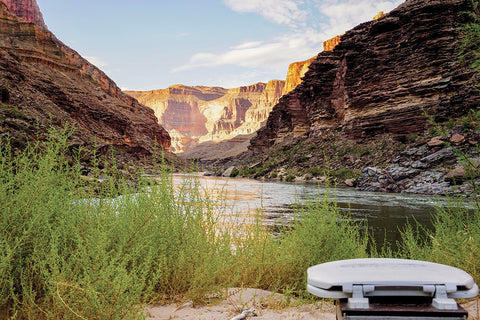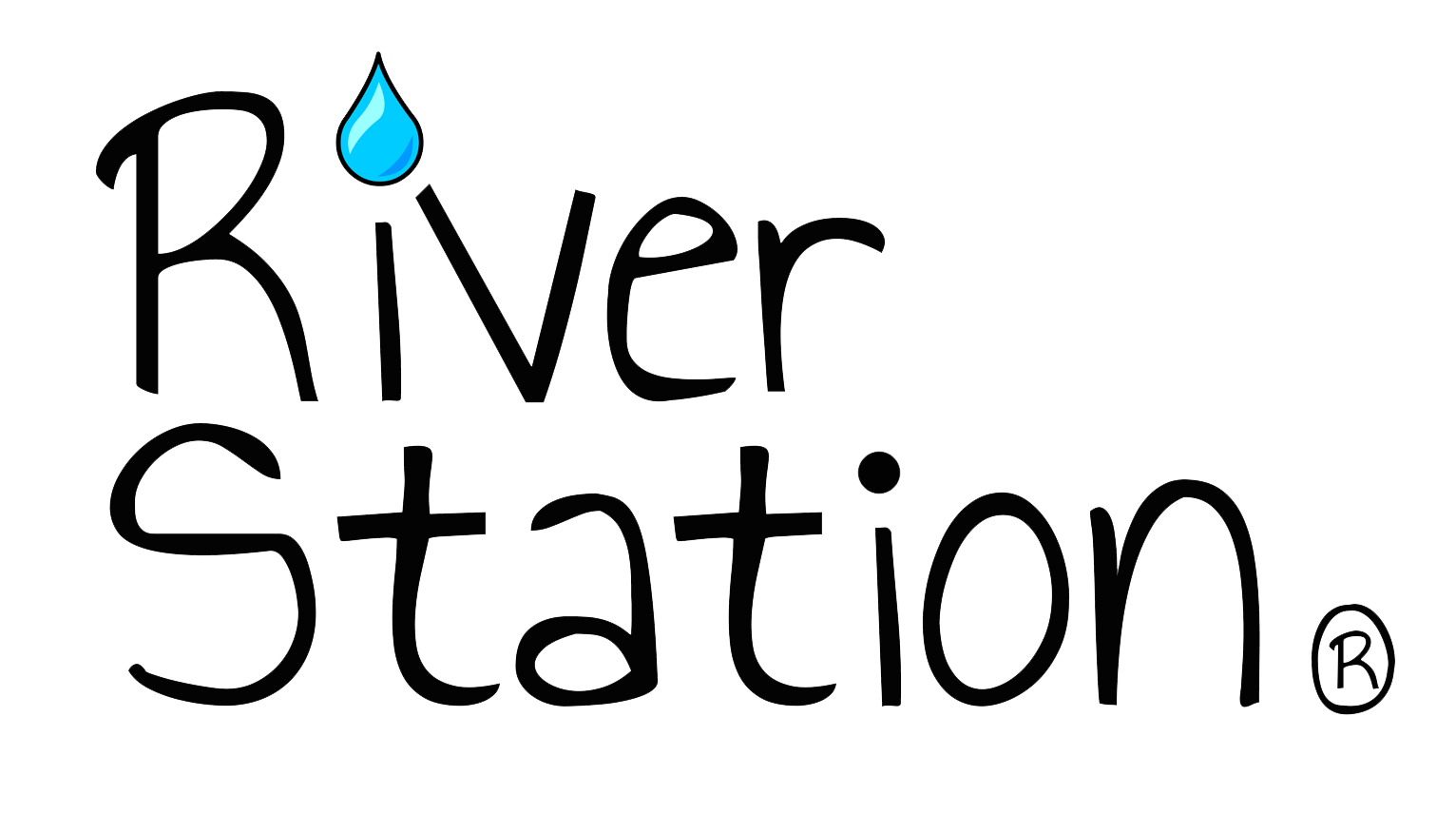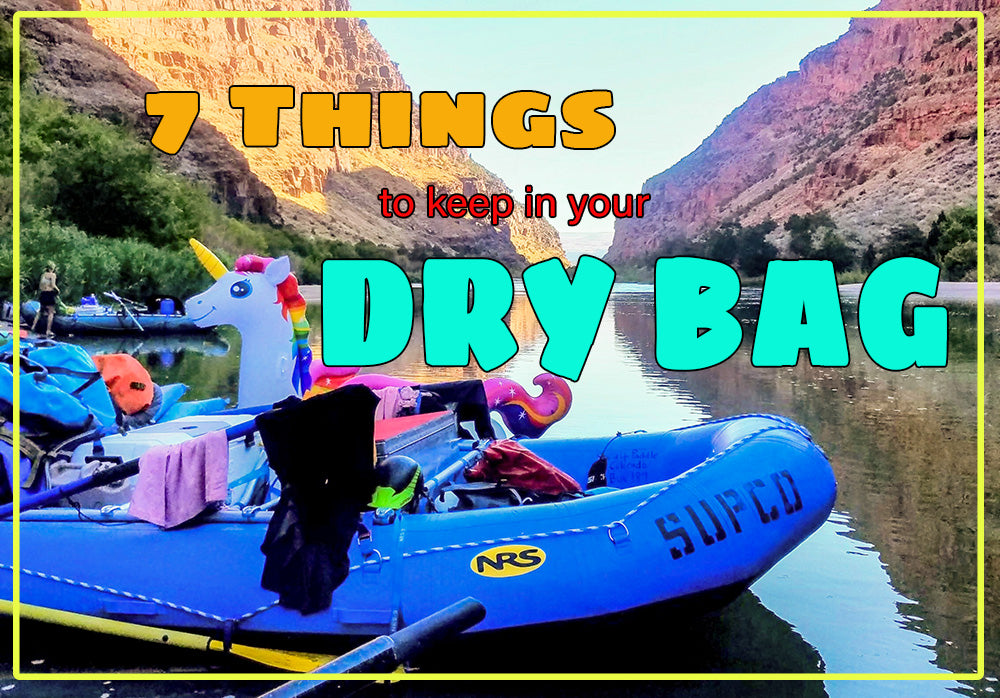A guide’s everyday rafting dry bag is like Mary Poppin’s bag, except completely waterproof. You never know what they might pull out of it.
We know guides who always carry a pound of coffee, diaper rash cream, sleeping bags, and cigarettes, even though they don’t smoke. Still, others always have duct tape, headlamps, a candle (for starting fires), loose tobacco, and so on.
And the truth is, there’s good reason to carry all the above and more. We asked you guys what raft guides should keep in their dry bags and got a consensus on a few items. Check it out.

Extra Layers
Some days your guests refuse to take a wetsuit and splash top; the next thing you know, you have shivering bow paddlers. Or your after-hours lap takes longer than expected, and you're freezing your butt off waiting for shuttle.
You’ll be glad you have extra layers in your dry bag during these times. Splash tops, fleeces, and warm hats can be a lifesaver for cold boaters. You can also carry gloves and extra splash pants. Any dry clothes can make a huge difference to a cold guest.
Consider bringing a few lightweight layers for sun protection. If you notice a guest getting roasted in your boat, offer them a sun shirt or pair of shorts from your dry bag. (Full service = full tips…hopefully.)
Pro Tip: Don’t give guests anything you would mind losing. Pack your dry bag with extra layers from a second-hand store or a free pile.
Snacks
A hungry guide is a dangerous guide, and a hungry guest is an unhappy guest. In other words, bring snacks in your dry bag. Even for half-day trips, having snacks is a must. Besides keeping folks happy, dry bag snacks are essential for diabetic blood sugar emergencies.
Some of our favorite dry bag river snacks include:
- Jerky
- Trail mix
- Granola bars (non-crumbly preferred)
- Gummy bears
- Dried fruit
- Pretzels
When sharing snacks with your group, ask that everyone pours from the bag instead of reaching in. This will reduce germ transmission.

Toilet Paper
Toilet paper is a ‘better to have and not need’ item. Pit toilets might not be stocked, or someone has a side-of-the-river emergency. Besides the obvious, you can offer toilet paper for a runny or bloody nose.
In addition to toilet paper, carrying feminine hygiene products in your dry bag should be standard practice.
First Aid Kit
Even if your outfitter sends a first aid kit out with every trip, you still need a personal kit in your dry bag. If you’re heading out on a fun run or get separated from the group first aid, a personal kit can save the day.
As a bare minimum, you can bring a pre-made first aid kit. You can also build your own. Most basic first-aid setups will include:
- Adhesive bandages in a variety of sizes
- Gauze
- Gloves
- Antiseptic wipes
- Safety pins
- Instant cold compress
- Aspirin
- Antibiotic ointment
- Roller bandage
Consider adding glucose tablets, an antihistamine, a lighter, an emergency blanket, and a sam splint to your dry bag kit. Some guides also carry a towel in their dry bag. This will be useful if you need to dry a patient off before applying bandages or AED pads.

Wrap Kit
Sometimes, things go wrong, and it’s best to be prepared. You don’t need to carry a 100-foot rescue rope and heavy-duty pulleys in your personal dry bag. Hopefully, your outfitter has a beefed-up safety kit handy. For a small dry bag wrap kit, include the following:
- Four locking carabiners (you can get away with three, one on your water bottle, one on your flip line, and one on your throw bag.)
- Three pulleys (Pulleys are great tools for reducing friction in your rope system, but not strictly necessary.)
- Two prussics (Make sure they are a smaller rope diameter than your throw bag line.)
- Webbing (For setting up anchors. The webbing in your flip line works)
- Rope (A throw bag with 3/8“ diameter rope is best. A waist belt throw bag likely won’t be strong enough.)
Chances are, you already carry locking carabiners, rope, and webbing. All you need to add to your dry bag is pulleys and prussics, and you’ll have a worthy wrap kit.
Sunscreen
We know many river runners who take great pride in their PFD tans. Even if you don’t wear sunscreen, your guests will be grateful for another sunscreen layer, especially on full-day trips. Sunscreen, a sun hat, and extra sunglasses in your dry bag can make your guest’s experience that much better.
If you’re worried about the sunscreen exploding in your dry bag and getting everywhere, keep it in a mesh bag instead. We also recommend keeping water bottles in a mesh bag or mesh duffel bag.
Dry bags are great for keeping gear dry, but if a water bottle leaks, you will have a bag full of wet gear. Plus, the closure system on a mesh thwart bag allows guests easy access.
Games
Stash a few games in your dry bag for shuttle waits or downtimes. For example, a hacky sack or cribbage board can make time pass faster. There are also tons of fun river games that don’t require anything extra.
You can turn an upside-down raft into a slip-and-slide, play tug-o-war with a throw bag, or try a simple game of eye spy.
What’s in Your Dry Bag?
River runners, guides, and private boaters alike should never go out without their waterproof dry bags. What you put in it is another thing entirely, although extra layers, snacks, and a first aid kit are a good place to start.
What’s the most random thing in your dry bag? Let us know in the comments, and don’t forget to share this with your river rat friends.
By: Megan McPartland
Check out our raft bag lineup!





Share:
You’re Invited to a River Costume Party
Should You Keep a River Log?